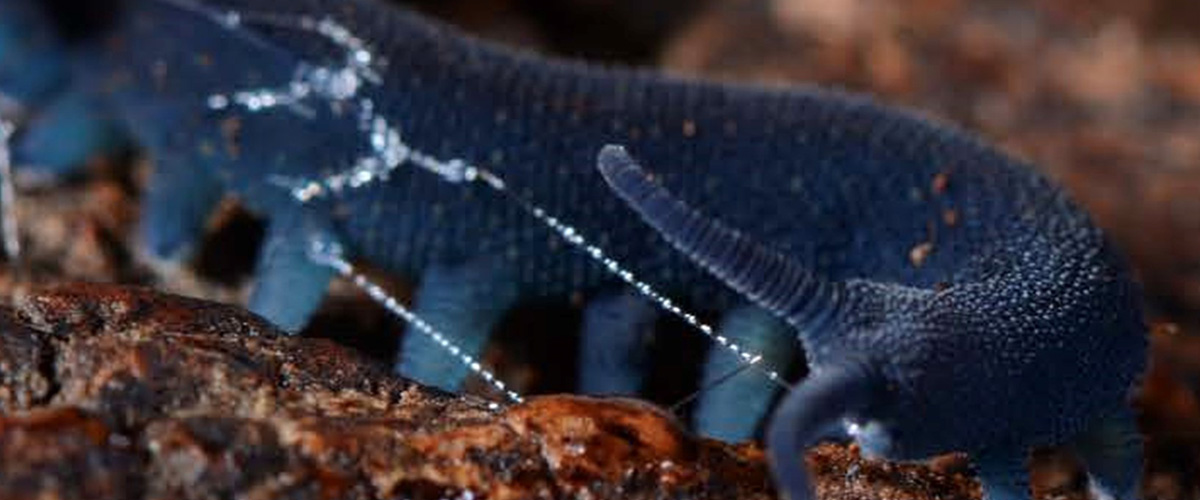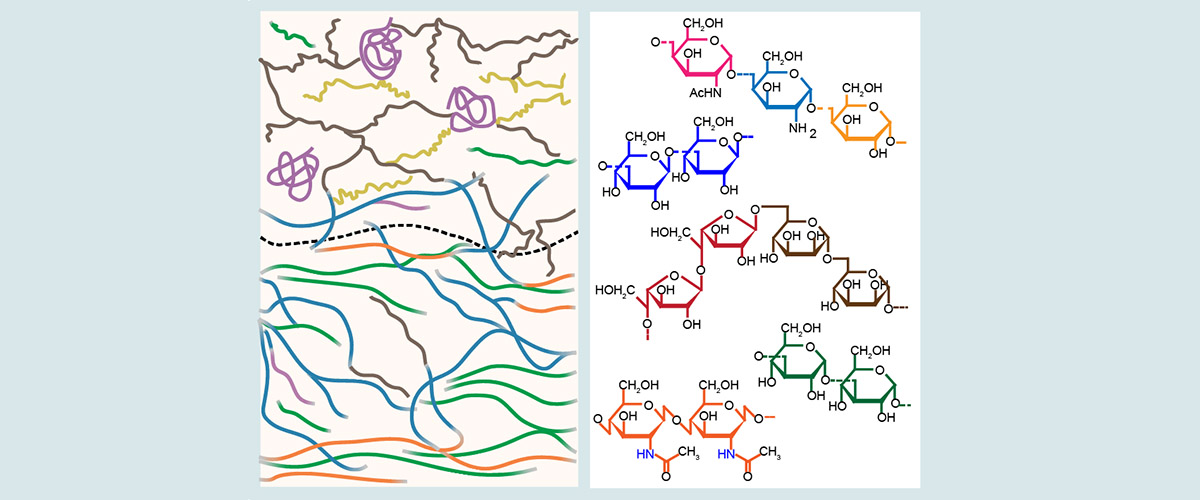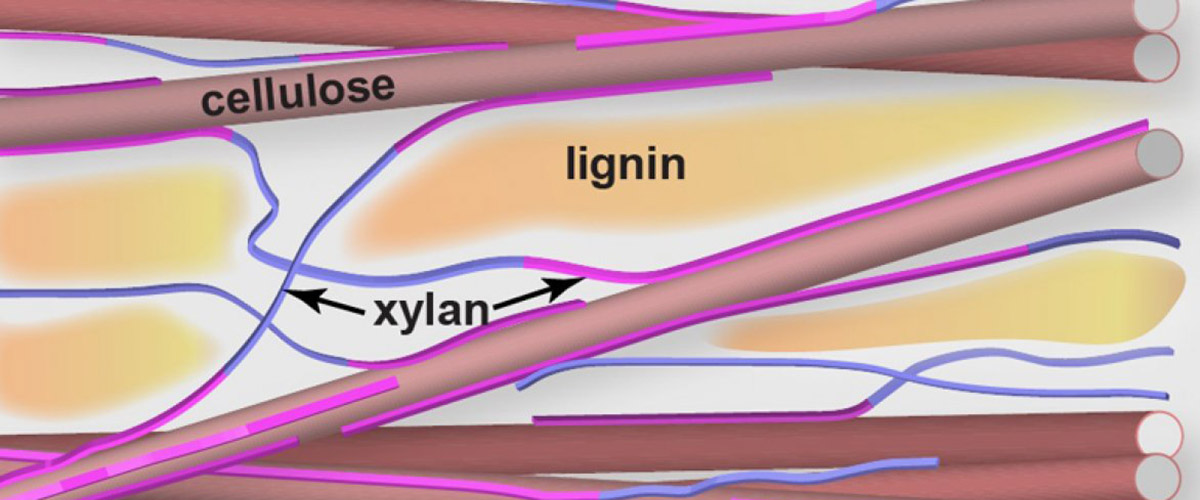Contacts: Frederic Mentink-Vigier
TALLAHASSEE, Fla. — Researchers at the National MagLab are helping to unravel the mysteries of a marvel natural material dubbed “silly string of death.” Detailed analysis using high magnetic fields and unique instruments is providing new insights about the complex composition of velvet worm slime, which has long fascinated scientists because of its remarkable qualities.
Slime shooting specimen of the velvet worm species Principapillatus hitoyensisfrom, Costa Rica.
Creative commons Baer et al. 2017, Nature Communications
The projectile slime slung by velvet worms rapidly transitions from liquid to gel to solid. Terrifying for the prey it traps but tantalizing for scientists seeking to understand the complex substance and inspire new, sustainable materials.
“It’s a unique mechanism developed, evolved just by this animal,” said Alexander Baer, postdoctoral researcher at the University of Kassel in Germany and co-author of a new paper on the slime’s molecular composition published in The Journal of the American Chemical Society.
An international collaboration led by Prof. Matthew J. Harrington from the chemistry department at McGill University and Georg Mayer, a zoology professor at the University of Kassel has been studying the slime for more than a decade. In this study, Prof. Isabelle Marcotte’s team from the Université du Québec à Montréal brought their expertise in spectroscopic analysis of biomolecules to the collaboration. And the group turned to the MagLab for the unique equipment needed.
“We want to find out how nature is working here. And there is still a lot to be learned,” Baer said.
The velvet worm, found in the tropics of the Southern Hemisphere including South America and Australia, looks like a slug crossed with a cartoon caterpillar. Its hunting method seems dreamed up by a horror writer. The worm shoots sticky fluid from tubes on its head to attack its prey from up to a foot and a half away. The slime becomes gel mid-air.
“It’s almost creating a net already in the air. The poor insect watching, there’s no way to escape,” described Alexandre Poulhazan, Baer’s coauthor, who studied the slime while earning his doctorate at Université du Québec à Montréal and is now a postdoctoral researcher at Stanford.
The slime solidifies into glassy adhesive fibers after it hits its target, trapping the victim. That allows the slow-moving worm to bite into the catch with bladelike jaws, dissolve its innards with saliva, and devour the prey.
“It’s a killing machine,” said Marcotte.
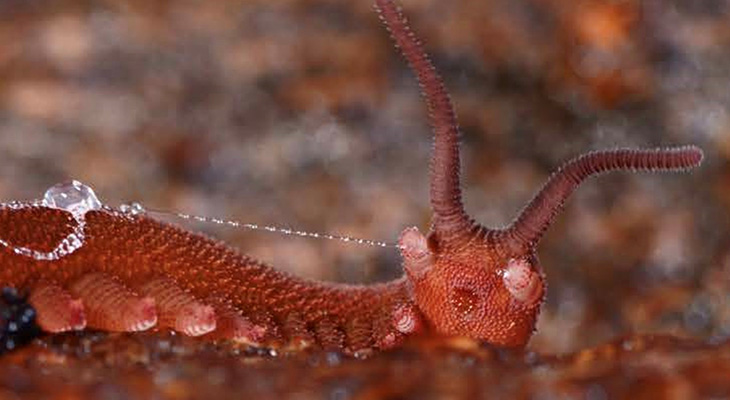
Velvet worm species Epiperipatus barbadensis shooting its slime, which transitions from liquid to gel to solid, trapping its prey.
When Poulhazan explained to MagLab researcher Frederic Mentink-Vigier that the team needed help scrutinizing the slime of this “creepy” animal, he was all in.
“This is so cool. What is this stuff and how does it work?” Mentink-Vigier said, “Just being able to look at something no one else is able to look at, and trying to understand something that is not understood… it’s exciting.”
The MagLab’s high magnetic fields and unique equipment helped Mentink-Vigier and Poulhazan analyze the molecular composition of the worm slime at a detail not possible anywhere else. They turned to the MagLab’s Nuclear Magnetic Resonance (NMR) instrument that combines Magic Angle Spinning with Dynamic Nuclear Polarization. It rotates the sample at a high speed and enhances the NMR signals of the sample using microwave irradiation.
“This is the type of application where this instrument really ‘shines’”, said Mentink-Vigier.
The construction of a new probe at the Maglab by the radio-frequency group was critical. It enabled detecting phosphorus and carbon efficiently.
The MagLab analysis found something unexpected — a rare phosphorous-carbon molecule, called a phosphonate, linked to large proteins in velvet worm slime. Phosphonates are common mainly among marine microorganisms such as ocean bacteria, but it’s believed to be a very rare finding in terrestrial invertebrates.
“We have managed to prove we have that weird molecule in there,” said Poulhazan.
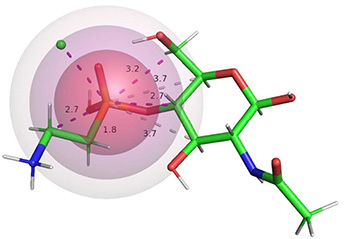
3D rendering of the structure of phosphonates found in velvet worm slime.
“Collaboration with the MagLab was very important,” said Marcotte. “The fact we had access to this probe and instrument… it really was a game changer.”
The researchers also confirmed the rare protein modification in two velvet worm species who branched apart on the evolutionary tree some 380 million years ago. This conservation points to the protein’s key role in the slime.
“It’s a whole machinery to make the protein, make the modification, make it outside of the cell, make it in the slime, stable in the organism. We know it’s there for a reason. Biology is always for a reason,” said Poulhazan.
“If that has been conserved for so many years of evolution, it must be very important. Otherwise why would you keep it? Evolution would have eliminated it. It stayed, and that’s what makes it intriguing and then the hunt is on to understand what this is,” said Mentink-Vigier.
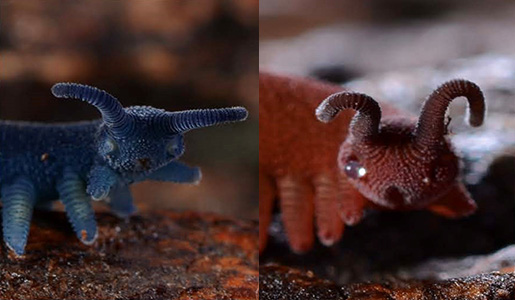
The two species of velvet worm studied, Euperipatoides rowelli (l) and Epiperipatus barbadensis (r).
Baer says the hunt now leads to many new questions about the slime’s composition and the interconnected protein fibers at its core that give the liquid its remarkable properties.
“We continue looking at the phosphonate story. Where are the linking sites in the proteins, which proteins are modified, which amino acids are modified. Identify the proteins, sequence the proteins that are important in the slime,” Baer said.
The unique chemical makeup and mechanical properties could one day be the blueprint for new sustainable plastics, glues, cements, or pastes.
“We have this material that can be some kind of adhesive, and it’s recyclable, that’s a property that’s probably very useful,” said Marcotte.
“People are really fascinated about this material,” Baer noted, saying he’s never at a loss for collaborators.
Perhaps many researchers are drawn to what Mentink-Vigier describes as the “creepy stuff” surrounding the velvet worm. A cute, colorful creature that’s also a terrifying predator.
“When you see it, it’s velvety and it has a nice color. And then at the end,” the trapping its prey and eating them alive part, “it’s such a bummer,” said Marcotte.
Thankfully, the worms are no bigger than your hand or so, and they’re only after bugs. Not that they haven’t slimed humans.
“When you open the jar, it can happen,” Baer recounted with a laugh about being slimed at his lab in Germany where he raises the worms.
“It was good. I found out the slime tastes bitter,” he said.
A small price to pay for unraveling the secrets of a natural phenomenon.
Researchers at the University of the West Indies in Barbados, the University of Georgia, and Heinrich-Heine University in Dusseldorf also contributed to the research.



